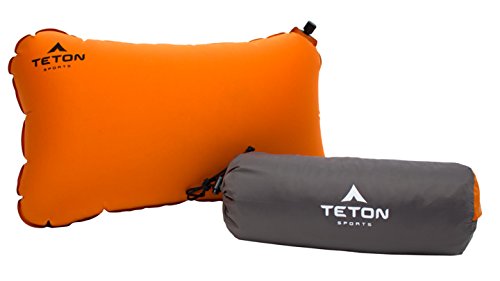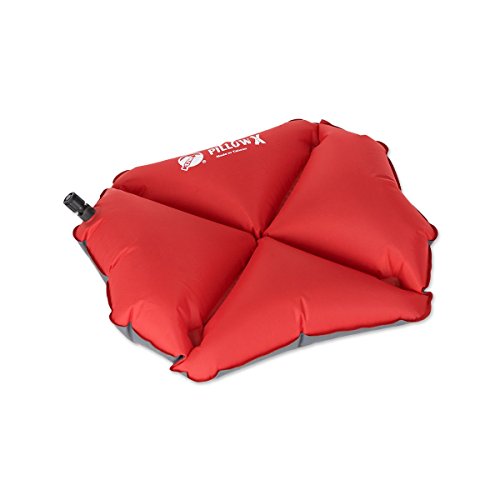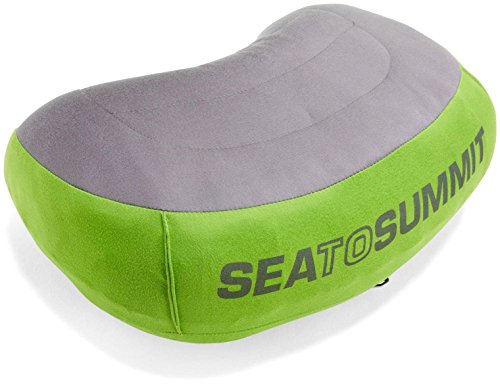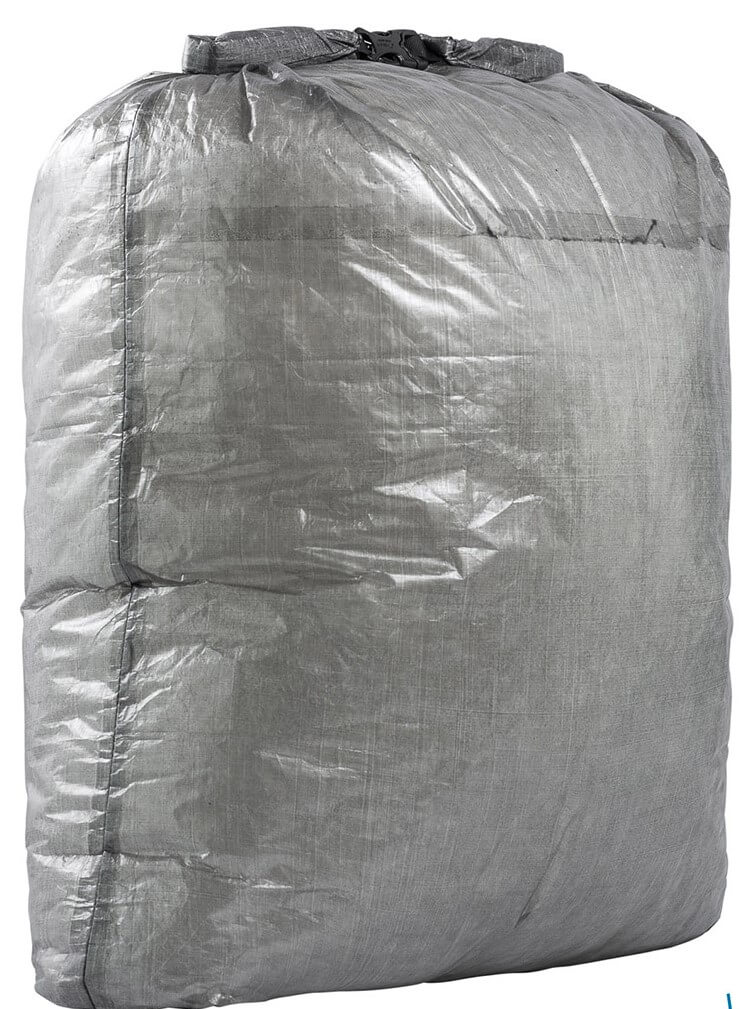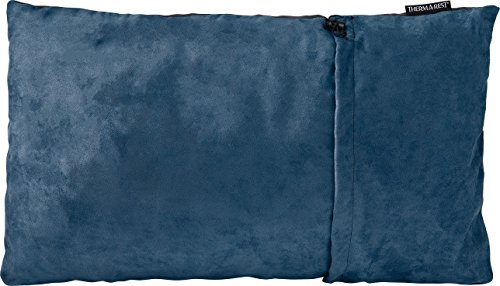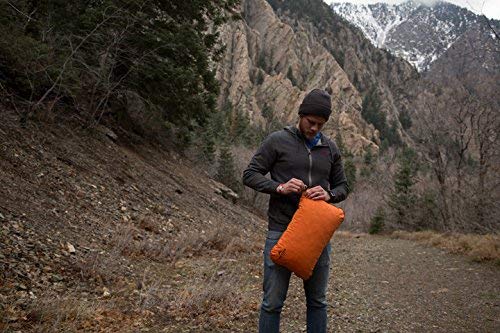
Updated December 2020
When you head into the woods for a backpacking trip, chances are your pillow isn’t the first thing on your mind or packing list.
But nevertheless, if you’re like me, having a pillow can make or break your trip. In fact, there are two things I must have to get rested for another long day of hiking: a good sleeping pad
and a comfy pillow.
Now, I’m an ultralight die-hard and I usually just use a stuff sack filled with other hiking clothes, but this is usually stinky and only mildly comfortable. With advances in manufacturing and materials, it’s totally possible to pick up a lightweight and comfortable pillow at a great price these days and, honestly, I’ll be jealous!
First, we’re going to talk about what criteria to look for when selecting your next backpacking pillow. Then we’re going to dive into a few of the best backpacking pillows you can get your hands on and why I like them.
Let’s get to it!
Comparison Chart
Name | Price | Weight | Rating | Notes |
|---|---|---|---|---|
$$$ | 14 oz | A 3" I-beam baffled air cell eliminates the 'balloon' feeling of traditional camp pillows and creates a more natural shape that cradles your head. | ||
$$$ | 4.3 oz | RF welded seams to ensure high strength and durability | ||
$$$ | 7.68 oz | Hybrid-fill design combines the cushioning of air with the lofty support of polyester fill to maximize comfort | ||
$$$ | 3.5 oz | Small in Size - Big on Comfort! This is the most compact & lightweight inflatable camp pillow on the market – folds down to 5x2 inches | ||
$$$ | 12 oz | No pump required; packs to 13x3.5x3.5 inches | ||
$$$ | 1.95 oz | Packs to an ultra compact 4.5” x 2.5”x 1”– about the size of a lighter | ||
$$$ | 4 oz | Synthetic fill between pillow case and TPU bladder increases comfort and wicks away perspiration | ||
$$$ | 10.4 oz | Brushed polyester cover is soft against skin for comfort; lofty urethane fill is an upcycled byproduct of Thermarest mattresses | ||
$$$ | 0.5 oz | These bags are sewn "envelope" style with a taped seam down the side and across the bottom | ||
$$$ | 2.08 oz | Pillow back is made up of a slip resistant material to prevent your head from moving |
How to Choose the Best Pillow for Backpacking
Picking out a great pillow involves understanding the pros and cons and matching that with your backpacking style and preferred sleep arrangement. Of course, you can do my move and stuff clothes in an old bag, but there’s no substitute for a great night’s rest on the trail – trust me!
Inflation Method
Do you want to puff your pillow full of air every night, or would you rather just open up the valve and let the pillow do the work?
Self-inflating pillows may be more convenient but they’re heavier and bulkier. However, because they don’t ever get hot, moist breath inside of them they are less likely to get moldy or gross. This can extend the life and attractiveness of your pillow.
Manual inflating pillows require a breath of fresh air every time you want to inflate them. Unlike manually inflated mattresses, however, they only take about one breath to puff full. They’re lightweight because they don’t have internal foam, and they pack down tiny!
Packability and Weight
These go hand in hand and they’ll change based on which type of inflation method you pick. See the section above for more details on inflation methods.
I always recommend keeping bulk and weight to a minimum whenever possible. That being said, many would consider the pillow to be an “essential” item due to it standing between us and a good night’s sleep. If you’re in this category I would still recommend a manually inflatable pillow because, frankly, no one needs a self-inflating pillow. Keep it simple.
By opting for a manually inflatable pillow you’ll get all the comfort of a pillow with a fraction of the weight and bulk that come from a more traditional foam or self-inflating pillow.
On our list, I’ve included both self-inflating and manual inflating pillows. If you’re backpacking for days in remote settings and need the lightest possible pillow for a good sleep you’ll find it here. You’ll also find tons of good pillows for preferences in between ultralight and ultra-comfortable.
Sleeping Preference
Pay careful attention to how you like to sleep before you pick up a pillow. Some backpacking pillows are for side sleepers, while others are for back-sleepers. But of course all pillows will suffice for either.
To get the most out of your backpacking pillow, look for pillows that contour and hold your head. Because backpacking pillows are so small, it can be a real challenge to actually keep your head on it while you sleep. Contoured pillows help a ton with this!
I’ve outlined several pillows in our reviews that will work for back sleepers or side sleepers. I’ve also picked out a few that can be bought in larger sizes or contours that help keep your head centered.
Backpacking Pillow Materials
Every backpacking pillow I’ve seen is made to hold air in some way. That means they’re made from materials that are impermeable. So what?
Well, impermeable materials in the backpacking world include things like coated nylon, polyester blends, dyneema composite, and other space-age materials. So why aren’t our pillows at home made from this stuff? These materials aren’t always ideal for resting your head.
Here are some things to keep in mind with pillow materials:
Cuben fiber is crazy lightweight. However, like those old Sun Chips bags, it’s super loud and crinkly. While covering it with fleece or a layer of clothes can help, it may still bother some sleepers.
Foam filled pillows that are “self inflating” add a substantial amount of weight to the pillow and prevent it from packing down all the way when not in use.
Here’s an example: the Nemo Fillo (foam filled) hits the scales at 9.2 ounces overall while the Zpacks Medium Pillow Stuff Sack (no foam) is a featherlight 1.4 ounces. That’s a difference of 7.8 ounces! That might not sound like a lot to some, but to ultralight hikers that’s a big deal!
Fleece lined pillows are super comfortable! While they may add a little weight compared to truly barebones ultralight pillow options, I’d argue it’s probably worth it.
Here’s an example: the Zpacks Medium Dry Bag weighs 0.7 ounces while the Medium Dry Bag fleece covered pillow weighs 1.4 ounces. That’s a difference of 0.7 ounces total which I feel is probably a great trade for improved sleep quality.
Inflation valves while this is probably minor to most people, keep in mind that many dedicated pillows have an inflation valve. This plastic component can break easily and adds weight to the pillow overall (though I don’t have one on hand to weigh it).
Water Weight in Your Pillow
How does water get into a pillow? From your breath.
It happens in pillows and sleeping pads both - anything you breathe into to inflate. There’s a lot of moisture in human breath and that moisture can get trapped in your equipment.
Over time, particularly if you’re breathing into a pillow with a foam core, that moisture can get trapped and build up as condensation.
How much water weight? Probably not much. You’d have to weigh your pillow out of the box and then weight it again after a few trips. But that moisture can also lead to mildew and degradation of the pillow materials.
One way to minimize or eliminate this is by using an inflation bag. An example of this is the Big Agnes Pumphouse.
Note:
Carrying this bag almost certainly weighs more than any moisture from your breath in a pillow. However, if you’re already carrying a sleeping pad that you want an inflation bag for, then you could also use this bag to fill your pillow which could help.
Why spend money at all? Try this instead…
There are two obvious ends of the backpacking pillow spectrum. On one end is the luxury inflatable pillow crowd. On the other end is the no-pillow-at-all crowd. What if I told you, though, that there’s a secret perfect middle ground and it’s totally free?
Now, don’t get me wrong - if you just love sleeping without a pillow altogether then keep doing that (but why are you reading this article?). Alternately, if you struggle with neck issues and a pillow is the right solution, then please carry one for your health and comfort.
For the rest of you, just wait a second before you put the cart in front of the horse. You probably already have a free, effective pillow to use on the trail packed in your bag already. It’s your clothing bag!
Using a stuff sack partially filled with clothes is a great way to save money, weight, and space in your pack.
This is one of the reasons I like to use a waterproof stuff sack for my clothes on the trail as opposed to a bag liner. With your clothes in a stuff sack you can take them out when you get to camp, adjust the bag a bit, and you’ve got your pillow ready to go.
There are some pros and cons to this method, however. Let me talk you through them.
Pros
Cons
So, after all this did I convince you to try using your clothes as a pillow?
Despite some of the drawbacks, there’s a lot to like about the clothes bag as a pillow method. For instance, your dry bag should be waterproof - therefore you won’t actually drool on your clothes.
Here are a couple of tips if you do decide to use your clothes bag as a pillow…
- 1Try a dry bag that’s made to be used as a pillow like the Zpacks pillow bag. It has fleece on the outside which makes it much more comfortable on your face and tames down the crinkling and crackling of the bag in your ear.
- 2If your pillow bag scoots around as you sleep, try putting some silicone strips on it so that the bag sticks to your tent floor. Seam sealer will work fine for this.
- 3Don’t give up on it until you try adjusting how much clothing is in your bag, how much air is trapped in there, and how tight you roll the dry bag.
- 4Keep yourself clean on the trail. Use a gallon size freezer bag and some environmentally safe soap to wash your clothes when they smell too bad to sleep on.
- 5Once you have your dry bag set up as a pillow, pull a layer of clothes over it to act as a pillow case. This reduces noise, helps hold it in place, and keeps it soft and comfy on your face.
Now, after all that, you should be able to decide if using your clothes as a pillow is the right choice for you. It’s not for everyone. However, if you like lightweight, simple systems for backpacking then I highly recommend it!
The Top Backpacking Pillows
A good night’s sleep might be worth its weight in gold after a long day on the trail and a few extra ounces to recharge your batteries is probably worth it. While this one is heavy, it’s thick and large enough to feel just like your home pillow!
- 20”x11”x4”
- 12 ounces
- Cover included
Nemo took it a step further than many pillows by loading this one up with features. Inside you’ll find a foam filling. This helps self-inflate the pillow when you open the valve. It also adds a much more comfortable “pillow” feeling - rather than feeling like a pool toy like many backpacking pillows.
Inside is a set of baffled air chambers designed to make the pillow inflate and hold a shape like a normal pillow. According to Nemo it packs down “to the size of a grapefruit” which seems big to me, but you may not mind it.
This is a great choice if you struggle to get comfortable enough to achieve a good night’s sleep on the trail.
While I think this is a well-rounded option, it may be too much in the center of the pack to make a name for itself. Lightweight and comfortable, but not exceptional this pillow splits the difference of weight vs comfort.
- 4.3 ounces
- Size not listed
- Polyester pillow case
At 4.3 ounces for a comfortable pillow with a nice fiber covered case it’s actually not bad in terms of weight. Because it’s not filled with anything, it will pack down very small which is great compared to the Fillo.
Maybe the thing I like the most about the pillow is the design. It’s raised on all edges and a bit lower in the center which should help a lot with keeping your head on the pillow throughout the night.
Overall the price, weight, and features put this pillow right in the middle of many other good choices so it’s hard to narrow it down.
There’s a careful balance to be struck between lightweight, packable backpacking pillows and comfort. Klymit aimed right at the center of that spectrum with this pillow to keep it appropriate for the trail but comfy enough to feel at home.
- 6.2 ounces
- Polyester/air fill hybrid
- 22”x12.5” inflated size
Combined with the polyester filling, the quilted cover makes for an extremely comfortable rest. Plus it has the size to allow the flip-floppers among us to sleep comfortably. Fortunately, it packs down pretty well but it’s still 7”x3” packed down so it’s far from minimalistic.
Short of carrying an actual pillow on the trail, this one might be one of the more generous ones on our list. It’s a good one to check out if you struggle to get a good rest on “plasticy” feeling inflatable backpacking pillows.
There are a handful of things that define a good pillow. It needs to be affordable, comfortable, lightweight and packable. This one checks those boxes and gets it done with style.
- 3.5 ounces
- 16”x12”x4”
- Anti-slip dots on the bottom
There’s a lot to like here from the affordable price to the attention to detail. I love that they added anti-slip dots on the bottom of the pillow to keep it from slipping. They also added an optional strap you can use to keep the pillow in place on a sleeping pad.
It is available in 5 colors if that matters to you. Maybe the only downfall of this pillow is that there’s no cover. Pull a shirt over it before you doze off for a comfy face-feel and you might just have the best value pillow on our list.
STILL A TOP CONTENDER IN 2019
This pillow tops our list for one main reason: extreme value for the price. I know many of you want to stretch those dollars for all their worth! With a moderate size, self-inflating features, and a great price this is a good choice for many reasons! Those who want self-inflating ease will have it at their fingertips while also saving some cash.
Weighing in at 12oz, it’s not a lightweight pillow by any means but at least it comes in under a pound, eh?
I like that even with a steal of a price, the pillow still comes with a nice cloth outer. This is awesome so you won’t have to wake up in a pile of your own drool on a plastic pillow. Trust me, I’ve done it more times than I’d like to admit. Cotton is better than nothing but I would’ve loved to see this pillow come with a synthetic fabric top for longevity and a potential increase in wicking.
- 12 ounces
- 33cm x 9cm x 9cm
- 2 colors
NEW FOR 2019!
As a major ultralight backpacking proponent, I have to turn my attention to these excellent lightweight options. This pillow is essentially a ripstop nylon airtight ball that has been cut into an X shape.
On our list this pillow is by far the lightest weight pillow other than the zPacks Stuff Sack Pillow. So, if you want to save ounces and you’re tired of sleeping on a bag of dirty clothes this is the solution for you!
This causes the edges of the pillow to bulge in comparison to the center which falls inward. What that means for you is a secure hold all night long so this is perfect if you’re tired of having your head roll off the pillow in the middle of the night.
- 1.9 ounces
- 38cm x 28cm x 10cm
- Multiple colors
Best for those who want the lightest possible standalone pillow.
Premium is a really good title for this pillow, I must say. I love the lined polyester knit fabric on the outside. Not only is it comfortable, it’s a great fabric pick. This keeps your face dry and comfy while you’re sleeping. Of course, while all these things aren’t strictly necessary, they make carrying a pillow worth the effort.
Many hikers choose to use a bag full of clothes as a pillow because it doesn’t weigh anything extra or take up more space in the pack. In my view, any pillow then has to justify weighing down the pack and taking up space by being better than a bag of clothes and this one definitely is better.
This is the first pillow we’ve reviewed here that is offered in multiple sizes. If you’ve ever tried to spend a night on an inflatable sleeping pad with an inflatable pillow, then you’ll understand how easy it is to roll off. If this is a problem or concern for you, then the larger pillow size will definitely help. I like that the design is well-thought and effective. They even included some padding under the wicking face fabric.
- 2.8 ounces (Regular)
- 34cm x 24cm x 11cm (Regular)
- 2 colors – 2 sizes
Best for those who want a lightweight pillow with the comfortable touch of microfiber fleece to sleep on.
Therm-a-Rest is hands down one of my favorite gear makers in the backcountry market going into 2019. Their parent company also makes MSR and Platypus products which I highly recommend.
Of all the items we’ve reviewed, the Therm-a-Rest Compressible Pillow comes in the most diverse number of options. It’s totally self-inflating, using some kind of magical future-foam to compress to 1/4 or less of its expanded size when packed. I personally love that Therm-a-Rest decided to offer the pillow in a total of 32 different options! That’s 8 colors each of which come in 4 sizes you can pick from.
- 9 ounces (Medium)
- 36cm x 45cm x 10cm
- 32 color and size options
While it’s certainly not going to make any ultralight lists, it’s a solid piece of gear that can help you get a better nights rest and wake up recharged like you do at home.
Best for those who struggle to gain a good night’s sleep on the trail and want more comfort.
Ready for something a bit different? If you’re like me you probably hate carrying extra weight unless you absolutely have to. Backpackers who count every gram will appreciate the zPacks Pillow Dry Bag.
This dry bag has a fleece lining on one side which allows you to still use the old “clothes in a sack” method for a pillow without having plastic on your face all night. I’ve used cuben fiber dry bags as pillows many times and I can say they’re not pleasant. So, instead of rolling around on plastic all night, this might be a great solution.
At 1.4 ounces it’s twice the weight of the same dry bag without the fleece liner. That makes this pillow a total of 0.7 ounces and it is, officially, the best ultralight backpacking pillow by weight on our list. It takes up practically zero room when packed, too!
Note: The thickness of this pillow depends on how many clothes (and air) you leave in it.
- 0.7 ounces
- 25cm x 47cm x ?cm
- Doubles as a stuff sack
Best for ultralight backpackers who want to save every ounce!
At about half the price and a very similar design to the Sea to Summit brand pillow that ranks higher on our list, how come this pillow lives a bit lower?
Well… it seems to be to be a direct knock off. Normally I wouldn’t mind that, but even if they didn’t directly copy I get the feeling that Trekology cut a few corners to undercut Sea to Summit’s successful Aeros pillow.
One area where this pillow falls behind is that the head area does not have a softer fabric covering. While other pillows on our list also avoid soft fabric coverings and you can solved this by putting a shirt over the pillow as you sleep, I think it’s worth noting the difference.
Note: In my research I’ve seen this exact same pillow with various brand names on it – I’m not sure who is actually manufacturing this pillow. It might have made the top of our list but I don’t trust customer support from an unknown maker which just can’t compete with the lifetime warranty on the TETON Sports pillow.
- 2.75 ounces
- 40cm x 30cm x 10cm
- Comparable to many other pillows at a very low price
Best for those on a budget who want something comparable to top brand pillows at a low price.
See something to rest your head on?
It’s important to be comfortable when out on the trail. A good-night’s sleep makes it easier to deal with those long days of trekking and ensures you’re more alert. So if you’re committed to using a pillow while out backpacking, invest in a good ones that both comfy and lightweight.
If you can’t find a pillow that does it for you from this list, you might as well go back to the ol’ stuff sack trick.




